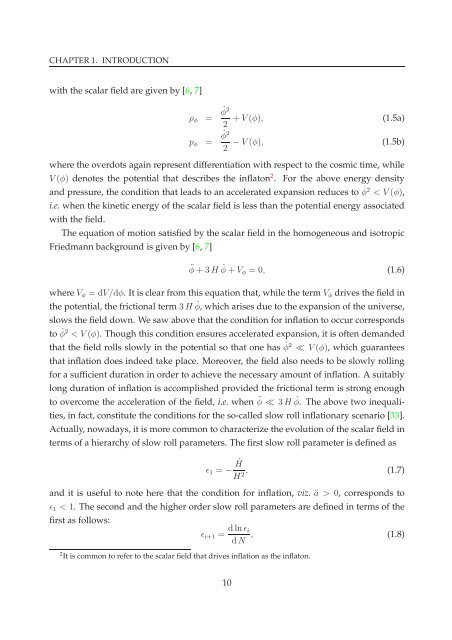PHYS08200605006 D.K. Hazra - Homi Bhabha National Institute
PHYS08200605006 D.K. Hazra - Homi Bhabha National Institute
PHYS08200605006 D.K. Hazra - Homi Bhabha National Institute
Create successful ePaper yourself
Turn your PDF publications into a flip-book with our unique Google optimized e-Paper software.
CHAPTER 1. INTRODUCTION<br />
with the scalar field are given by [6, 7]<br />
ρ φ = ˙φ 2<br />
+V(φ), (1.5a)<br />
2<br />
p φ = ˙φ 2<br />
−V(φ), (1.5b)<br />
2<br />
where the overdots again represent differentiation with respect to the cosmic time, while<br />
V(φ) denotes the potential that describes the inflaton 2 . For the above energy density<br />
and pressure, the condition that leads to an accelerated expansion reduces to ˙φ 2 < V(φ),<br />
i.e. when the kinetic energy of the scalar field is less than the potential energy associated<br />
with the field.<br />
The equation of motion satisfied by the scalar field in the homogeneous and isotropic<br />
Friedmann background is given by [6, 7]<br />
¨φ+3H ˙φ+V φ = 0, (1.6)<br />
whereV φ = dV/dφ. It is clear from this equation that, while the termV φ drives the field in<br />
the potential, the frictional term 3H ˙φ, which arises due to the expansion of the universe,<br />
slows the field down. We saw above that the condition for inflation to occur corresponds<br />
to ˙φ 2 < V(φ). Though this condition ensures accelerated expansion, it is often demanded<br />
that the field rolls slowly in the potential so that one has ˙φ 2 ≪ V(φ), which guarantees<br />
that inflation does indeed take place. Moreover, the field also needs to be slowly rolling<br />
for a sufficient duration in order to achieve the necessary amount of inflation. A suitably<br />
long duration of inflation is accomplished provided the frictional term is strong enough<br />
to overcome the acceleration of the field, i.e. when ¨φ ≪ 3H ˙φ. The above two inequalities,<br />
in fact, constitute the conditions for the so-called slow roll inflationary scenario [33].<br />
Actually, nowadays, it is more common to characterize the evolution of the scalar field in<br />
terms of a hierarchy of slow roll parameters. The first slow roll parameter is defined as<br />
ǫ 1 = − Ḣ<br />
H2, (1.7)<br />
and it is useful to note here that the condition for inflation, viz. ä > 0, corresponds to<br />
ǫ 1 < 1. The second and the higher order slow roll parameters are defined in terms of the<br />
first as follows:<br />
ǫ i+1 = dlnǫ i<br />
dN , (1.8)<br />
2 It is common to refer to the scalar field that drives inflation as the inflaton.<br />
10
















